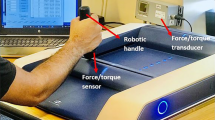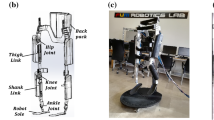Abstract
As an innovative concept, an optimal predictive impedance controller (OPIC) is introduced here to control a lower limb rehabilitation robot (LLRR) in the presence of uncertainty. The desired impedance law is considered to propose a conventional model-based impedance controller for the LLRR. However, external disturbances, model imperfection, and parameters uncertainties reduce the performance of the controller in practice. In order to cope with these uncertainties, an optimal predictive compensator is introduced as a solution for a proposed convex optimization problem, which is performed on a forward finite-length horizon. As a result, the LLRR has the desired behavior even in an uncertain environment. The performance and efficiency of the proposed controller are verified by the simulation results.
Similar content being viewed by others
References
Akdogan E and Adli M A, The design and control of a therapeutic exercise robot for lower limb rehabilitation: Physiotherabot, Mechatronics, 2011, 21: 509–522.
Christian H, Andy A, Patrick C, et al., Walking and running with passive compliance: Lessons from engineering: A live demonstration of the ATRIAS biped, IEEE Robotics and Automation Magazine, 2018, 25: 23–39.
Calanca A, Muradore R, and Fiorini P, A review of algorithms for compliant control of stiff and fixed-compliance robots, IEEE/ASME Trans. Mechatronics, 2016, 21: 613–624.
Ghajar M H, Keshmiri M, and Bahrami J, Neural-network-based robust hybrid force/position controller for a constrained robot manipulator with uncertainties, Trans. Inst. Meas. Control, 2018, 40: 1625–1636.
Le Flohic J, Paccot F, Bouton N, et al., Application of hybrid force/position control on parallel machine for mechanical test, Mechatronics, 2018, 49: 168–176.
Raibert M H and Craig J J, Hybrid position/force control of manipulators, J. Dyn. Syst. Meas. Control, 1981, 103: 126.
Khoshdel V, Akbarzade A, Naghavi N, et al., sEMG-based impedance control for lower-limb rehabilitation robot, Intelligent Service Robotics, 2018, 11: 97–108.
Towhidkhah F, Gander R E, and Wood H C, Model predictive impedance control: A model for joint movement, J. Mot. Behav., 1997, 29: 209–222.
Souzanchi K M, Arab A, Akbarzadeh T M R, et al., Robust impedance control of uncertain mobile manipulators using time-delay compensation, IEEE Trans. Control Syst. Technol., 2018, 26: 1942–1953.
Hogan N, Impedance control of industrial robots, Comput. Integr. Manuf., 1984, 1: 97–113.
Akdogan E, Aktan M E, Koru A T, et al., Hybrid impedance control of a robot manipulator for wrist and forearm rehabilitation: Performance analysis and clinical results, Mechatronics, 2018, 49: 77–91.
Huang H, Crouch D L, Liu M, et al., A cyber expert system for auto-tuning powered prosthesis impedance control parameters, Ann. Biomed. Eng., 2016, 44: 1613–1624.
Meng W, Liu Q, Zhou Z, et al., Recent development of mechanisms and control strategies for robot-assisted lower limb rehabilitation, Mechatronics, 2015, 31: 132–145.
Zhang X, Yue Z, and Wang J, Robotics in lower-limb rehabilitation after stroke, Behavioural Neurology, 2017, 2017: rticle ID 3731802, 13 pages.
Seraji H, Adaptive admittance control: An approach to explicit force control in compliant motion, Proceedings of 1994 IEEE Int. Conf. Robot. Autom., San Diego, CA, USA, 1994.
Khoshdel V and Moeenfard H, Variable impedance control for rehabilitation robot using interval type-2 fuzzy logic, Int. J. Robot., 2015, 4: 46–54.
Fateh M M and Khoshdel V, Voltage-based adaptive impedance force control for a lower-limb rehabilitation robot, Adv. Robot., 2015, 29: 1003–1013.
Jamwal P K, Hussain S, Ghayesh M H, et al., Impedance control of an intrinsically compliant parallel ankle rehabilitation robot, IEEE Trans. Ind. Electron., 2016, 63: 3638–3647.
Kalani H, Moghimi S, and Akbarzadeh A, Towards an SEMG-based tele-operated robot for masticatory rehabilitation, Comput. Biol. Med., 2016, 75: 243–256.
Guo C, Guo S, Ji J, et al., Iterative learning impedance for lower limb rehabilitation robot, J. Healthc. Eng., 2017, 2017: Article ID 6732459, 9 pages.
Li X, Liu Y H, and Yu H, Iterative learning impedance control for rehabilitation robots driven by series elastic actuators, Automatica, 2018, 90: 1–7.
Karimian M, Towhidkhah F, and Rostami M, Application of model predictive impedance control (MPIC) in analysis of human walking on rough terrains, Int. J. Appl. Electromagn. Mech., 2006, 24: 147–162.
Veneman J F, Kruidhof R, Hekman E E G, et al., Design and evaluation of the LOPES exoskeleton robot for interactive gait rehabilitation, IEEE Trans. Neural Syst. Rehabil. Eng., 2007, 15: 379–386.
Meuleman J, Van Asseldonk E, Van Oort G, et al., LOPES II - Design and evaluation of an admittance controlled gait training robot with shadow-leg approach, IEEE Trans. Neural Syst. Rehabil. Eng., 2016, 24: 352–363.
Van Der Kooij H, Koopman B, and Van Asseldonk E H F, Body weight support by virtual model control of an impedance controlled exoskeleton (LOPES) for gait training, Proceedings of the 30th Annual International Conference of the IEEE Engineering in Medicine and Biology Society, Vancouver, Canada, 2008.
Chen Y, Hu J, Peng L, et al., The FES-assisted control for a lower limb rehabilitation robot: Simulation and experiment, Robot. Biomimetics, 2014, 1: 2.
Gendrin M, Gauthier J, and Lin-Shi X, An impedance control using a finite control set model predictive controller, Proceedings of 2015 IEEE International Symposium on Predictive Control of Electrical Drives and Power Electronics (PRECEDE), Valparaiso, Chile, 2015.
Zhakatayev A, Rubagotti M, and Varol H A, Closed-loop control of variable stiffness actuated robots via nonlinear model predictive control, IEEE Access, 2015, 3: 235–248.
Teramae T, Noda T, and Morimoto J, EMG-based model predictive control for physical humanrobot interaction: Application for assist-as-needed control, IEEE Robot. Autom. Lett., 2018, 3: 210–217.
Sharifi I, Doustmohammadi A, and Talebi H A, A safe interaction of robot assisted rehabilitation, based on model-free impedance control with singularity avoidance, IAES Int. J. Robot. Autom., 2015, 4: 98–108.
Lin F J, Chang C K, and Huang P K, FPGA-based adaptive backstepping sliding-mode control for linear induction motor drive, IEEE Trans. Power Electron., 2007, 22: 1222–1231.
Lin F J and Lee C C, Adaptive backstepping control for linear induction motor drive to track periodic references, Electr. Power Appl. IEE Proc., 2000, 147: 449–458.
Lin F J, Chen S G, and Sun I F, Intelligent sliding-mode position control using recurrent wavelet fuzzy neural network for electrical power steering system, Int. J. Fuzzy Syst., 2017, 19: 1344–1361.
Wu J, Gao J, Song R, et al., The design and control of a 3DOF lower limb rehabilitation robot, Mechatronics, 2016, 33: 13–22.
Author information
Authors and Affiliations
Corresponding authors
Additional information
This paper was recommended for publication by Editor CHEN Benmei.
Rights and permissions
About this article
Cite this article
Jalaeian-F., M., Fateh, M.M. & Rahimiyan, M. Optimal Predictive Impedance Control in the Presence of Uncertainty for a Lower Limb Rehabilitation Robot. J Syst Sci Complex 33, 1310–1329 (2020). https://doi.org/10.1007/s11424-020-8335-5
Received:
Revised:
Published:
Issue Date:
DOI: https://doi.org/10.1007/s11424-020-8335-5




